Miriam the Prayer Leader
Miriam’s song at first glance appears to simply be a refrain taken from the song of her brother:
Moses. “Sing to the Lord, for He is highly exalted; Horse and driver He has hurled into the sea.” (Ex 15:20-21)
However, both the nature of the song and its content are significant. The term ‘vataan lahem Miriam’ – ‘and Miriam chanted for them’, implies that Miriam served as a prayer leader. Commentators suggest that she lead the women in a responsive chanting of the Song of the Sea. A manuscript attributed to Rabbi Saadya Gaon, (found in the Boedlean Library) claims that Miriam’s technique set the precedent for other prayers as well:
And Miriam said responsively. She said one stanza and they repeated it, using this method for the entire song. This is the intention of Micah “And I shall send before you Moses, Aaron and Miriam; indicating that Miriam was sent to sing the song of the Lord. Note that Miriam said eighteen lines and the women answered her, so too when the chazzan says the shemonah esrei (the eighteen benedictions) the community answers every blessing with Amen. Similarly, on Passover when hallel is recited, after some of the verses the congregants answer, ‘Praised be the L’ and after some verses they answer, ‘Let me praise G for He is good’.
But what did Miriam actually say? The single verse uttered by Miriam contains the quintessential message of Moses’ song. It speaks of the glorious triumph of G who defeated the Egyptian horses and riders at Sea. ‘Ashira l’H ki Gao Gaah sus verochvo rama bayam’ – ‘Sing to the Lord, for He has is highly exalted’; Horse and driver He has hurled into the sea.’. In Rabbinic literature, an attempt was made to delve into the theological message encapsulated in those few words.
I will sing unto the Lord, for He is highly exalted. It is written, ‘Deck thyself now with majesty and excellency (Job 40:10). All things exalt themselves over something else; darkness exalts itself over the deep, because it is above it, and the wind exalts itself over the water because it is above it; fire exalts itself over the wind because it is above it, and the heavens exalt themselves over the fire, because they are above it, but God is exalted over everything – hence ‘For He is Highly exalted’.
(Exodus Rabbah 23:13)
Miriam’s Song
In contrast to Miriam’s telegraphic song recorded in the Book of Exodus, the discovery of the Dead Sea Scrolls has revealed a more extensive composition known as Miriam’s Song. Seven lines of this song are partially preserved in the Reworked Pentateuch 4Q365:
- you despised [or: you plundered]
- for the triumph of…
- You are great, a savior…
- the hope of the enemy perishes and he is…
- they perished in the might waters, the enemy…
- and he exalted her to their heights… you gave…
- wor]ing a triumph
George J. Brooke, in his article, “Power to Powerless: The Long – Lost Song of Miriam” [1]Biblical Archaeology Review 20/3 (1994), notes that the central theme of Miriam’s song is that victory belongs to the powerless and is specifically brought about by the weak and down-trodden.
Brooke speculates that this song of Miriam may have been part of a Passover ritual recorded by Philo of Alexandria in the first century. The ritual was performed by a Jewish Egyptian group known as the Therapeutae, who shared many beliefs and practices with the Qumran community. They are sometimes called the Egyptian Essenes. The following is Philo’s description:
After the meal, they [the Therapeutae] celebrate the holy all-night festival, which is kept in the following way. All rise up together and in the middle of the feast form themselves first into two choruses, one of men, the other of women; a leader and conductor is chosen for each who is one most held in honor and most suitable. Then they sing hymns to God composed in many measures and melodies, sometimes singing together, and sometimes in harmony antiphonally, their hands and feet keeping time, and rapt with enthusiasm, they process or stand still, making the turns and counter-turns proper to the dance. Then, when each of the choirs has danced enough by itself separately, as if it were a Bacchic rite in which they had drunk of divine love, they mix and form a single choir out of the two, in imitation of what happened long ago beside the Red Sea in relation to the miracles wrought there. For the sea at God’s command, became to one side a cause of salvation, but to the other destruction… When they saw and experienced this work, greater than could be told, or imagined, or hoped for, both men and women were so enthusiastic that they formed a single choir and sang hymns of thanksgiving to God the savior, Moses the prophet leading off the men and Miriam the prophetess the women. In closest imitation of the choir of the Threapeutae, male and female, models itself and responsonally and antiphonally as the deep notes of the men mingle with the treble ones of the women, a harmonious symphony results, one that is pure music. Lovely are the thoughts, lovely the words, and noble the choristers, and the aim of thought and words and choristers alike is piety.
(Philo, On the Contemplative Life 83,88)
This fascinating ritual performed by the Therapeutae may be reflected by the Song of Miriam found in the Dead Sea Scrolls.
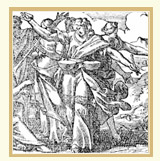
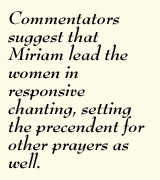
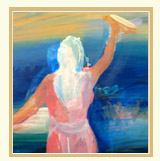
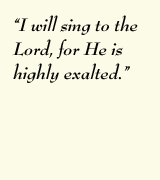

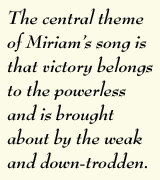
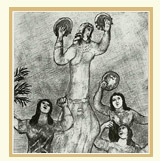
References
| ↑1 | Biblical Archaeology Review 20/3 (1994 |
|---|